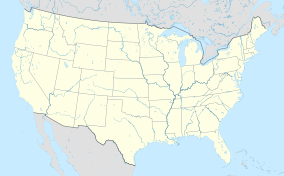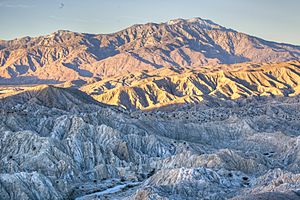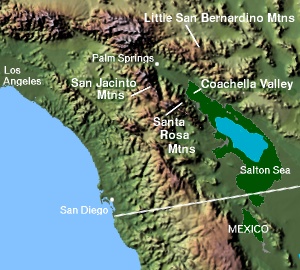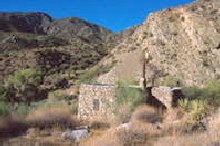Santa Rosa and San Jacinto Mountains National Monument facts for kids
Quick facts for kids Santa Rosa and San Jacinto Mountains National Monument |
|
|---|---|
|
IUCN Category III (Natural Monument)
|
|
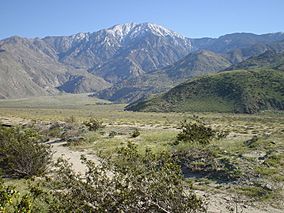 |
|
| Location | Riverside County, California, USA |
| Nearest city | Palm Springs, CA |
| Area | 280,071 acres (113,341 ha) |
| Established | October 24, 2000 |
| Governing body | U.S. Forest Service U.S. Bureau of Land Management |
| Website | Santa Rosa and San Jacinto Mountains National Monument |
The Santa Rosa and San Jacinto Mountains National Monument is a special protected area in southern California. It includes parts of the Santa Rosa and San Jacinto mountain ranges. These mountains are the northernmost ones in the Peninsular Ranges system. The monument is located in Riverside County, west of the Coachella Valley. It is about 100 miles (160 km) southeast of downtown Los Angeles.
Contents
About This Special Place
The Santa Rosa and San Jacinto Mountains National Monument was created in October 2000. It covers a huge area of 280,071 acres (113,341 ha). This monument is managed by two main groups: the US Bureau of Land Management (BLM) and the U.S. Forest Service.
Many plants and animals here are rare or endangered species. This means they are at risk of disappearing forever. One important animal is the Peninsular Bighorn Sheep. This type of sheep lives only in the Peninsular Ranges.
The Cahuilla peoples own a lot of land within the monument. They also help manage it. Their history and culture are deeply connected to these mountains. More than 200 important cultural sites have been found here. One of these is the Martinez Canyon Rockhouse. It is listed on the National Register of Historic Places.
Protecting the Land
People have protected this area since the late 1800s. It started as forest reserves. Then, in 1925, it became part of the San Bernardino National Forest. In 1928, Mount San Jacinto State Park was created. It includes 8,614 acres (34.86 km2) within the monument.
Later, in the 1960s, California began setting aside special areas. These were called ecological reserves. They help protect specific plants and animals. Today, there are three such reserves here. They cover 28,900 acres (117 km2) of state land. Other groups also help protect this area. These include the University of California Natural Reserve System and the Coachella Valley Mountains Conservancy.
The Wilderness Act of 1964 created the San Jacinto Wilderness. In 1984, the California Desert Protection Act added the Santa Rosa Wilderness. Many private groups also buy land to protect it. They help keep these mountains safe for everyone.
Mountains, Plants, and Animals
The monument stretches from northwest to southeast. It runs along the edge of the wide Coachella Valley. The land rises very steeply here. It goes from below sea level to almost 11,000 feet (3,400 m) high. These mountains are part of the Peninsular Range Province. This range goes all the way from Mexico to California. San Jacinto Peak is the highest point in this range. It has one of the steepest mountain faces in North America.
The big changes in height, temperature, and moisture create many different types of plants. The eastern side of the mountains is part of the Sonoran Desert. It is hotter and drier. The western side is closer to the Pacific Ocean. It gets more rain and has cooler temperatures.
You can find many plant areas here. These include sand dunes, chaparral, and mesquite. There are also areas with willows and cottonwoods near water. You can see desert fan palm oases and pinyon pine forests. The highest parts have lodgepole pine forests.
The San Jacinto Mountains are like an "island." They are surrounded by the Pacific Ocean to the west. To the east is the desert. To the north is the San Gorgonio Pass. This isolation has helped unique animals evolve. One example is the San Diego mountain kingsnake.
California fan palms (Washingtonia filifera) grow where there is permanent water. These palm groves are found in both the Santa Rosa and San Jacinto Mountains. Other plants in these oases include honey mesquite (Prosopis glandulosa) and arrow weed.
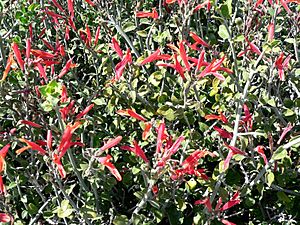
The largest plant group in the monument is called desert scrub. This includes creosote bush and burrobrush. You can also find many cacti here. Desert scrub covers over 160,000 acres (650 km2). It grows on rocky, well-drained soils. Animals living in the desert scrub include the protected Peninsular Ranges bighorn sheep and the desert tortoise.
Higher up in the mountains, you will find pine forests. These grow from about 5,500 to 9,000 ft (1,700 to 2,700 m) high. Trees here include Jeffrey pine, ponderosa pine, and sugar pine.
Some plants in the monument are very rare. These include Hidden Lake bluecurls. This plant is found in only one small area. Other rare plants are Nuttall's scrub oak and vanishing wild buckwheat.
Nineteen species are found only in the Santa Rosa and San Jacinto Mountains National Monument. This means they live nowhere else in the world. This makes them very special but also vulnerable. Some of these unique species are Johnston's rockcress and the Casey's June beetle.
The Bureau of Land Management lists eight animal species here as endangered, threatened, or rare. Most of these are protected by the federal government. The southern rubber boa is protected by the state. Besides the Peninsular bighorn sheep and the desert tortoise, other protected animals include the Coachella Valley fringe-toed lizard and the southwestern willow flycatcher.
Activities and Management
Many different groups help manage the Santa Rosa and San Jacinto Mountains National Monument. These include the Bureau of Land Management, the US Forest Service, and the Cahuilla peoples. The California Department of Parks and Recreation also helps.
Most fun outdoor activities are allowed here. You can go hiking, mountain biking, horseback riding, and camping. However, some special areas are protected. These include places where bighorn sheep live.
The Pacific Crest Trail goes through the western part of the monument. This is one of America's first National Scenic Trails. It is managed by the US Forest Service and the Bureau of Land Management.
The law that created the National Monument was introduced by Congresswoman Mary Bono in 2000. This law allowed for a plan to manage the area. It included working with groups like the Cahuilla peoples. It also kept most historical land uses. However, new mining and geothermal activities are not allowed.


